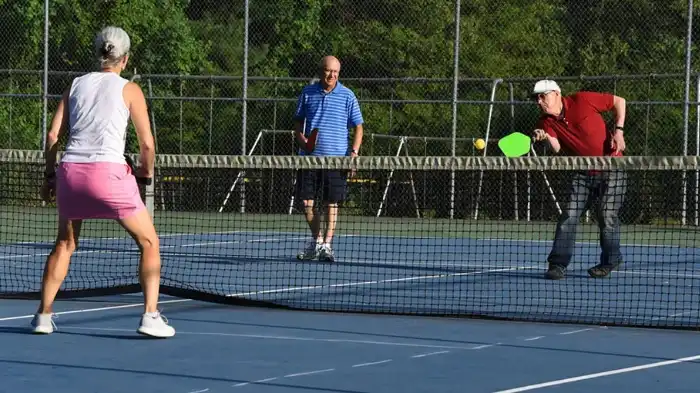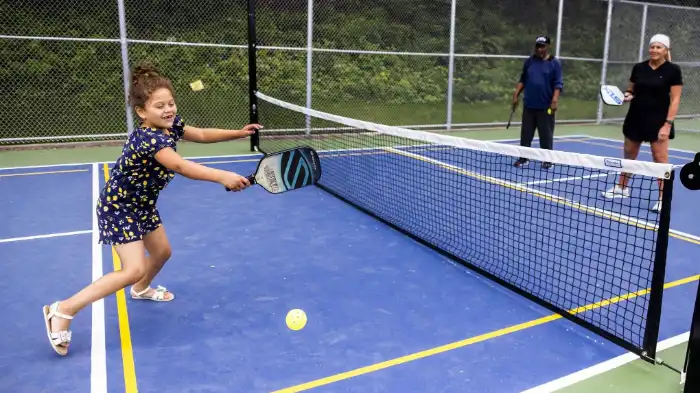Pickleball is a popular racket sport that combines elements of tennis, badminton, and ping pong. It is played on a court with a modified tennis net, a solid paddle, and a perforated plastic ball. While it may seem easy to pick up and play, there are common Pickleball Mistakes that beginners and even experienced players make. These Pickleball Mistakes can hinder your performance and prevent you from reaching your full potential.

Using the Wrong Grip
One of the most common Pickleball Mistakes is using the wrong grip. The grip is crucial for control and power in your shots. Many beginners tend to hold the paddle as if they were playing tennis, resulting in ineffective shots. The appropriate grip for pickleball is a continental grip, where the base knuckle of your index finger is on the third bevel of the paddle surface. This grip allows for versatility and flexibility in shots.
Not Moving Your Feet
Movement is a key aspect of pickleball. One of the biggest mistakes players make is not moving their feet enough. It’s essential to constantly adjust your position to be in the right spot for each shot. Failing to move your feet can result in being off-balance and unable to make accurate shots. Practice footwork drills to improve your mobility on the court and increase your overall performance.
Poor Shot Selection
Pickleball requires strategy and smart shot selection. A common mistake is always going for aggressive shots without considering the situation. It’s important to assess the game, your opponent’s position, and the desired outcome before attempting a shot. Sometimes, a soft shot or a defensive shot can be more effective than a powerful one. Make sure to analyze the situation and choose the appropriate shot accordingly.
Not Communicating with Your Partner
In doubles pickleball, communication with your partner is essential. A common mistake is not communicating effectively, which can lead to confusion and missed opportunities. Always establish clear signals and call out shots to avoid collisions and improve coordination. Effective communication can greatly enhance your team’s performance on the court.
Ignoring the Kitchen
The kitchen, also known as the non-volley zone, is a crucial area on the pickleball court. Many players make the Pickleball Mistakes of ignoring the kitchen and standing inside it during volleys. Stepping into the kitchen while volleying the ball results in a fault. It’s important to stay behind the kitchen line and only step inside it once the ball has bounced. Mastering proper kitchen play is vital to success in pickleball.

Conclusion
Avoiding common Pickleball Mistakes will help you improve your game and enjoy this exciting sport to the fullest. Remember to use the correct grip, stay mobile on the court, make smart shot selections, communicate effectively with your doubles partner, and respect the non-volley zone. By eliminating these mistakes from your game, you will enhance your skills and gain a competitive edge in pickleball.
Frequently Asked Questions
A1: The most common mistake beginners make in pickleball is hitting the ball too hard. It is important to focus on control and precision rather than power when starting out.
A2: To avoid getting stuck at the baseline, it is crucial to move forward and try to play the ball in the non-volley zone (kitchen). Staying closer to the net allows you to take advantage of the game and be more aggressive.
A3: The biggest mistake players make when serving in pickleball is faulting by hitting the ball into the net. To overcome this, focus on lifting the ball slightly, giving it enough height to clear the net.
A4: To improve consistency in pickleball, practice your footwork and positioning. Make sure you are in the right position to hit the ball by moving your feet quickly and efficiently, and avoid reaching for shots.
A5: Yes, always prioritizing power over placement is a common mistake. While power can be useful, it is essential to understand that placement is equally crucial. Instead of trying to hit a powerful shot every time, focus on placing the ball in hard-to-return spots on the court.

